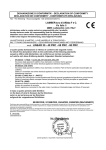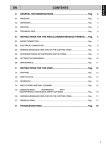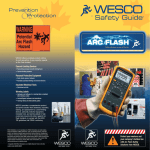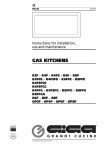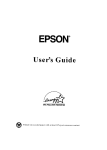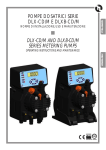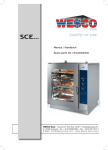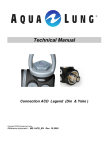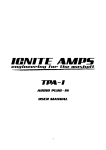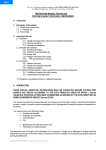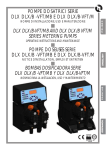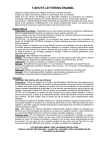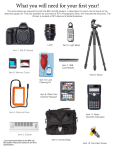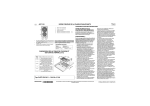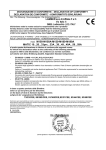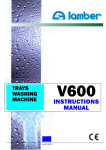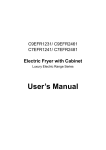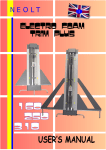Download Marine electric bratt-pan BTM manual - WESCO-Navy
Transcript
Manual / Handbuch Spare parts list / Ersatzteilliste Equipment Imp.-Exp. GmbH • Zitterpappelweg 9 D - 22391 Hamburg • Tel.: + 49 40 60009468-0 • Fax: + 49 40 536 75 01 E - M a i l : i n f o @ w e s c o - n a v y. c o m • w w w . w e s c o - n a v y. c o m • IMPORTANT WHEN THE UNIT SHOWS “LOW INSULATION”: IT IS NO DEFECT!!! IT IS A PHYSICAL PROCESS!! NO MANUFACTURING DEFECT!!! Please heat up the unit with MAXIMUM temperature. Go on heating, until the low insulation has disappeared!!! Reason: Inside the heating elements is magnesium oxide. This can absorbe moisture from the ambient air when not used for a longer time. PARAGRAPH PAGE DESCRIPTION 1.0 2 INTRODUCTION 2.0 2 GENERAL WARNINGS 3 INSTALLATION DRAWINGS 3.0 4 INSTALLATION 4.0 5 TRAUBLESHOOTING GUIDE 6 WIRING DIAGRAM 7 USE 8 MARINE ELECTRIC BRATT PAN 6.0 9 SPARE PART ORDERS 7.0 9 WARRANTY 8.0 10 CLEANING AND MAINTENANCE OF STAINLESS 5.0 1.0 INTRODUCTION These instructions are published for the use of personnel to whom the marine electrical tilting bratt unit BTM series. Each unit will have his own copy in English language, if requested and at extra cost, handbooks can be supplied in different languages. Wesco Navy is glad to offer You its congratulations for the purchasing of the present equipment that will certainly come up to Your expectations. You are kindly invited to carefully read all the information contained in the present “user manual” before installing and using the equipment. This manual contains important information concerning installation, use and maintenance of the equipment. Preserve with care the present manual for each further consultation of the various operators. The manufacturer declines each responsibility in the case in which the contents of this manual will not be respected. This equipment has been accurately checked before the delivery to the Customer. 2.0 GENERAL WARNINGS 2.1 Please read very carefully the content of this book because is giving very important indications for the safety installation, use and maintenance of unit. Keep this book in a safe and easy accessible place, for quick reference by all operators. Any packing material (plastic bags, polystyrene foam, nails etc.) as a potential source of danger, should be kept away from children's reach. 2.2 After removed the packing, check unit conditions, in case of doubt, do not operate the unit and consult an expert. This unit will be used only for the purpose has been specifically designed for any other use will be considered, as improper, therefore potentially dangerous. Installation to be done by qualified personnel in accordance to the manufacturer's instructions. The unit must be used by trained staff only (this unit is suited to be used from one operator only). 2.3 Before connecting unit, make sure the data on the machine's plate (located on the casing) correspond to the available electric power. The electric power connection system located as per installation diagram. When connecting unit to power line, provide an onnipolar switch with contact opening gaps, equals or superior of 3 mm. Power cord insulation will respond to the regulations in force. Do not keep it in pulled position. Use of multiple plugs and/or extensions, is prohibited. 2.4 Electric safety of this unit is conditioned to the connection of an effective earth system, as indicated from security regulation in force (unit must be incorporated in a unipotential system whose effectiveness must be verified according to regulations in force). It is essential to meet this safety requirement, in case of doubt, ask an expert to perform an accurate test on the system. The manufactured shall not be held responsible for any damages caused by failure to correctly earth the system. 2.5 Before starting unit, clean inside and outside as indicated in the instructions. Avoid tampering safety devices (which must be periodically tested by qualified personnel). In case of breakdown and/or malfunction, switch unit of; for any repair call a service centre authorised by the manufacturer, asking the use of original spare parts only. If above instructions will not be followed unit security can be at risk. 2.6 To prevent oxidation and chemical aggression in general, keep stainless steel surfaces clean at all times. At end of the day or work cycle, clean the machine as indicated in the instruction and switch of the unit. Before starting and cleaning or for maintenance operation, disconnect unit from main electric power, and be sure no one, can on it by any chance. Avoid the use of corrosive products, acids, steel wool or brushes when cleaning. Do not use direct or high pressure water jets. Should unit remain unused for a long period of time, apply Vaseline oil to the stainless steel surfaces and on the plates. 3.0 INSTALLATION 3.1 Positioning The overall dimensions/connections and technical data for each model are shown on the corresponding pages 3-4. Install the appliance in a suitably ventilated environment. Position the appliance at least 10 cm from surrounding walls. This distance may be reduced if the walls are flameproof or protected by insulating material. This appliance is not suitable for built-in installation. 3.2 Fitting Carefully remove the protective film from the external panels. Any traces of glue can be cleaned off using a suitable solvent. Level the appliance using the adjustable feet. For cantilever appliances, refer to the corresponding instructions. 3.3 Aligning appliances Position the appliances next to each other and level to the same height. Join the appliances using the lateral fixing holes. 3.4 Electrical connections The appliance is designed to operate at the voltage indicated on the rating plate. Make sure the power terminal block of appliance is connected to a separate duly rated power line (see the “Technical data” table). The power supply cable must be flexible and of a type matching at least the qualities of a rubber-type cable H 07 RN-F. The cable shall be connected to the main terminal board according to the instructions of the wiring diagram attached to the appliance. The earth wire must be longer than the other wires, so that in the event of the cable being jerked or the clamp broken, the live wires will disconnect first. The appliance must be fitted with homopolar safety cut-out switches of suitable capacity with a contact breaking distance of at least 3 mm, and highly sensitive differential protection device. The maximum leakage current is 1 mA/kW. 3.5 Earth and equipotential connection The appliance must be earthed. Inside the applicance, near the main terminal board, there a screw market with the symbol to which must be connected the earth wire. The appliance must be included in a correctly dimensioned equipotential system. The connection should be carried out using the screw marked with the symbol . WARNINGS Installation, modifications and maintenance of the appliance must be carried out by authorised personnel in compliance with current safety standards. The manufacturer declines all responsibility for failure to comply with these obligations. Testing the electrical system: switch on the appliance following the instructions for use and checkthe operation of the control devices, pan heating elements and safety devices: Main thermostat: Test the various temperature settings. Pan tilting selector: Tilt the pan up and down to test the limit switches. Heating element cut-out micro-switch (cuts in when the pan is raised): Tilt the pan up with the heating elements switched on. Make sure the heating elements cut out and switch back on againas soon as the pan is returned to the cooking position. 3.9 Testing the rated thermal power. Always check the thermal power of the appliance after installation and following maintenance work. The appliance functions at the rated thermal power when the electrical power supply voltage. ATTENTION If the electric power supply values switch off the appliance immediately. 4.0 TROUBLESHOOTING GUIDE 4.1 The pan heating elements do not heat up. Check the fuses. Main power switch not ON. Low voltage or incorrect electrical connection. Temperature control thermostat faulty. Main temperature control thermostat faulty, causing the safety thermostat to cut in (reset). One or more heating elements incorrectly connected or burnt out (replace faulty heating element). 4.2 The temperature control is difficult or impossible to regulate. Temperature control thermostat faulty. One or more heating elements incorrectly connected or burnt out (replace faulty heating element). 4.3 The pan tilting device is difficult to operate or noisy. The nut screws are worn and must be replaced. The tilting system’s moving parts (nut screws, screw, pins and linkages etc.) are poorly lubricated. Replacement of spare parts IMPORTANT Before carrying out maintenance work or repairs, disconnect the appliance from the power supply at the isolating switch. Do not tamper with any of the sealed components. 4.4 Pan heating elements. The heating elements are fixed underneath the pan by special plates and protected by an insulated housing. To gain access to theheating elements, remove the control knobs on the front panel, detach the front panel and ontrol panel and remove the front cover on the element housing containing the wiring connections. Raise the pan, detach the housing and locate the faulty element. Remove the element by undoing the fixing plate that covers it and replace. Remount the various parts following the above sequence in reverse order. 4.5 Main thermostat and safety thermostat Remove the front panel and upper control panel. Remove the bulb from the thermostat fixed underneath the pan at the front by a plate. Disconnect the electrical connections to the other devices. Replace the part. 5.0 USE 5.1 Turning on the bratt pan. To heat the pan, simply turn the thermostat control knob to the required temperature setting: 0 Off 50°C Minimum temperature 100-250°C Intermediate temperatures 300°C Maximum temperature (approx.) 5.2 Turning off the bratt pan To switch off the pan, simply turn the thermostat control knob back to 0. 5.3 Raising and lowering the bratt pan (emptying) The bratt pan may be raised or lowered whenever needed during cooking using the manual tilting device fitted on the appliance: Manual tilting device with front handwheel: Turn the handwheel clockwise to raise and empty the pan, and turn counter-clockwiseto return the pan to the cooking position. IMPORTANT: The contents of the bratt pan must be poured into a heat-resistant container. 6.0 SPARE PART ORDERS For eventual spare part orders you can contact our head office: WESCO Navy GmbH Zitterpappelweg 9, DE-22391 Hamburg Tel. +49 40 60 00 94 68 18 Telefax +49 40 5 36 75 01 e-mail: [email protected] Quoting as clear as possible the following data: Ship name and/ or hull no. Spare part code number Appliance model Brief explanation of spare part Feeding voltage of appliance 7.0 CLEANING AND MAINTENANCE FOR STAINLESS STEEL. 7.1 Before using any detergent to clean stainless steel surfaces and floors under and around equipment, always enquire your detergents supplier or retailer about the best products to be used for a particular cleaning.Remember that if the steel rusts up it is not because of it but because it was not treated with proper care, and you abused by using too strong bleaches and detergent. 7.2 For cleaning and maintenance of stainless steel parts follow these rules: Clean carefully and frequently all stainless steel parts with wet rags; soap and water or common detergents without abrasive slurry can be used. Rinse with pure water and dry carefully. Cleaning is important because with a clean surface the steel will make up a protective oxide that will prevent corrosion. When cleaning the equipment never splash water on because you can damage internal parts or components, and this can be very dangerous for your safety in case of electrically heated or operated equipment. 7.3 Food spots, hardened stains. To remove it use hot sudsy water for a few minutes, then rub with a cloth, soft brush or stainless steel pad. After brushing, rinse with hot water and dry with a soft cloth. 7.4 Hard water mineral deposits. To remove it, swab or cover the area with a water solution containing vinegar or phosphoric acid. Follow this with cleansing powder, then wash and rinse. Scratches on surface. For a high polish, apply a middy abrasive cleaner and rub in the direction of the polish lines to prevent scratches and preserve the original finish. Be careful not to rub in dirt that is on the metal surface. 7.5 To clean stainless steel never use chlorine products, like sodium hypochlorite, muriatic acids or similar ones. These products attack soon and fast the stainless steel and produce a corrosion that can not be removed. To clean floors under and around equipment never use the product above listed because vapours or eventual drips on the steel can cause corrosion problems as above explained. Never use iron wool to clean stainless steel appliance because small particles left on its surface can get it rusted; use stainless steel wool and rub in the direction of the polish lines. Avoid surface contact with iron materials to prevent corrosion. 7.6 Water pipes of outlet water system which feed pans, sinks, ranges, etc. produce rust, especially opening cocks after a rest period, or for newly-installed plants. It is necessary to prevent these oxides or iron deposit from being in contact with stainless steel parts. It is advisable that pipes be carefully galvanised and to let water flow until it is perfect clean. Prevent salt solution from evaporating or drying on the surface of steel. 7.7 For pans do not use kitchen salt in gross grains which, depositing on the bottom and being too heavy, could not circulate and dissolve completely; this salt not dissolved or dissolved in a long period, may cause corrosion in contact points. It is advisable therefore to use kitchen salt in small grains and put it into the pan after ebullition has begun, if it is not possible, dissolve the salt in other container. When pans are not used, they must be kept with lid opened to maintain and activate the film protecting steel from atmospheric oxidation. 7.8 Discoloration of stainless steel surface caused by burnt-on grease, food stains, or burns. To soften an especially heavy layer of burnt-on grease, cover it with ammonia- soaked cloth for 10 to 15 minutes. Then wash, rinse and dry. To polish burns apply a soft stainless steel wool or synthetic abrasive pad and rub in the direction of the polish lines to prevent scratches. Rust stains caused by inappropriate care and bad maintenance. Use correct products, enquire detergents manufactures ( Ex. Soilax Diversey Henkel Level Oakite Benckiser, etc.). Rely upon recommendations of your fabricator. A good agent that has given satisfactory result for eliminating rust stains is the Oakite 31/A, after its use rinse plentifully with water. WARNING: After cleaning, well-dried stainless steel parts must be protected with anti-corrosion products, which can be easily found in commerce. These, beside removing halos, restore brightness to the stainless steel, prevent penetration of humidity and dirt that cause.













